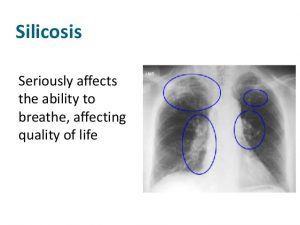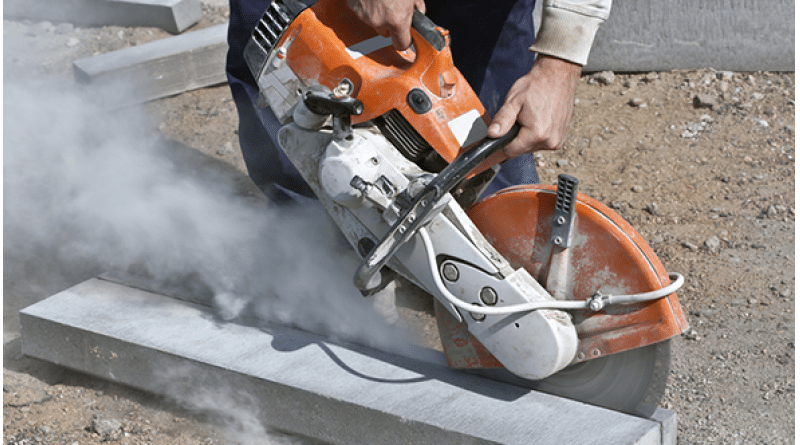Construction Dusts. What’s the big deal?
We’ve all been exposed to construction dust during our working lives, especially those of us who have been in the industry for quite a while, the introduction of face fitting masks is a relatively new step by the HSE to protect our health and has caused a stir among the hipsters in the trades! Chris Bowes explores the reasons behind the regulations……
“A bit of dust never killed anyone” “I have to wear a mask for cutting that?” “I can’t sweep up? You’re having a laugh!” “I’ve been cutting like this for years and I’m fine.”
Unfortunately a bit of dust over time can kill and yes, you should be using extraction or wearing that mask. No you shouldn’t be dry sweeping – and its only because the effects of working like this may not have caught up with you yet.
Where are you exposed to dusts at work? The following activities are examples where you will be exposed –
- Using a cut-off saw on kerbs, blocks, paving slabs, roof tiles and other concrete products
- Chasing, scabbling or grinding concrete
- Drilling or coring for long periods, particularly indoors
- Abrasive pressure blasting
- Cutting and sanding wood with power tools
- Sanding plasterboard jointing
- Dry sweeping
- Internal demolition and soft stripping.
Working around silica dusts, wood dusts and other dusts on sites can have fatal effects on people and also cause life changing illnesses in later life. At present the following is happening in the UK;
- Around 13,000 deaths each year from occupational lung disease and cancer
- Estimated that over 40% of new cancer registrations/deaths are to construction workers
- Estimated that more than 500 construction workers die from exposure to silica dust every year….more than 10 per week (which I think is conservative)
- Many more suffer life-changing illnesses
On top of this you may not be able to provide for yourself or your family in later life.

Now if we had 10 people being killed on sites every week there would be uproar and we would be changing how we work like installing edge protection and putting guards on tools, so why are we not all controlling works around dusts? I think because it’s not an instant accident or incident but is something that happens over a long period of time it is swept under the carpet (whoops no sweeping!!) and people don’t think about it or they just don’t realise how dangerous it actually is. It can cause cancer, because breathing difficulties change people’s lives forever. I have personal experience of how COPD (lung disease) can affect someone through work and it’s not nice. It changes how you live and how you are with your family and kids or grandkids. It is debilitating.
So what can we do?
Design out the problem – Do we need to chase out or can we board over? Can we surface mount? Use cable trays to prevent as much drilling? Looking at ways (and this also goes back to our architect friends who should be looking at these issues) to prevent works that create as much dust and require as much cutting
Control the dusts – use damping down techniques when cutting. Use water to suppress dust when using a cut-off saw but maintain these and also around the guard as they can clog up and this in turn can prevent people using them. Vacuum extraction on tools. An M class filter vacuum should be fitted on tools to capture the dusts. A dust bag will not capture the harmful dusts.
Damp down using water spray if sweeping or even better use a vacuum. Sweeping will only throw the dust in the air again and expose everyone working in the area.
Wear RPE – RPE should be worn and more importantly face fitted. The RPE must be tight to the face and with no gaps and yes this does mean you need to be clean shaved. If you do have facial hair there are other pieces of RPE that can be worn. There is mask for every face shape and beard out there and your PPE supplier can assist. If you need any assistance on face fitting RPE please do contact me on the details below. If there is the interest we can look at getting face fitting done around the country. HSE guidance is that everyone should be face fitted for RPE on a regular basis and if there are any changes to a person’s face through, for example, weight loss/gain and scars. [email protected]
If you are an employer you must assess the risks and document these if you employ 5 or more people. You must train your employees on working around dusts, how to maintain tools and how to use RPE correctly.
On top of the most important bit of it being harmful, not following guidance and protecting workers from dusts can lead to HSE improvement notices and prohibitions and fines……… we will cover this topic another time!!!
If you need to talk about this further or require any H&S services feel free to contact me on [email protected], or have a look at our website http://www.opexsafetyservices.co.uk/.
We can assist you in all aspects of H&S and training nationwide and discounted rates are available to BTG members.
For a range of free resources on construction dust please see the Construction Dust Partnership (CDP) website at http://www.citb.co.uk/cdp
Stay safe!!
Chris
To read Chris’s article on the CDM Regulations 2015, click here!



I didn’t used to care. Now I’m paying for it with a lung disease.
Fantastic read that I just bought a double filter mask not do anything now with out wearing my mask thank you sharman bullimore construction
Great to hear you found the article useful Sharman! Keep checking out the website, Chris will have more content coming up on Health and Safety, thanks for the feedback.